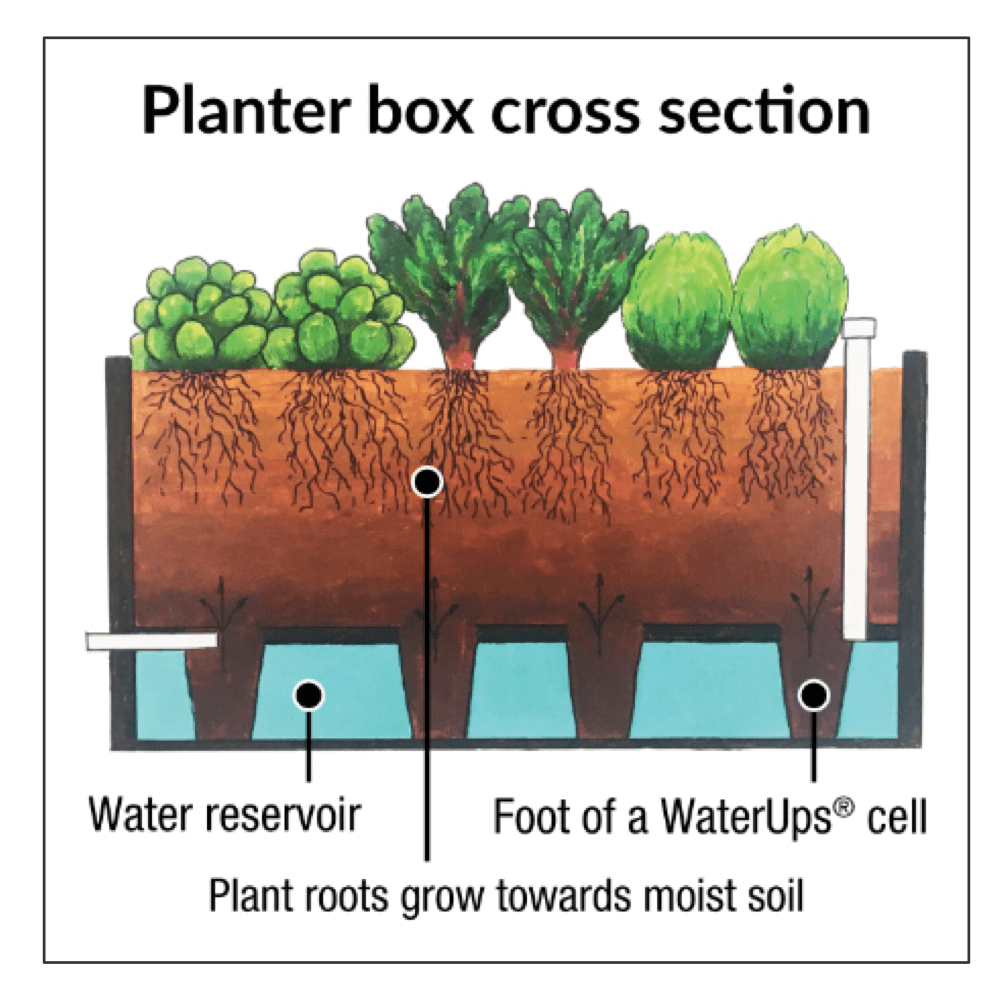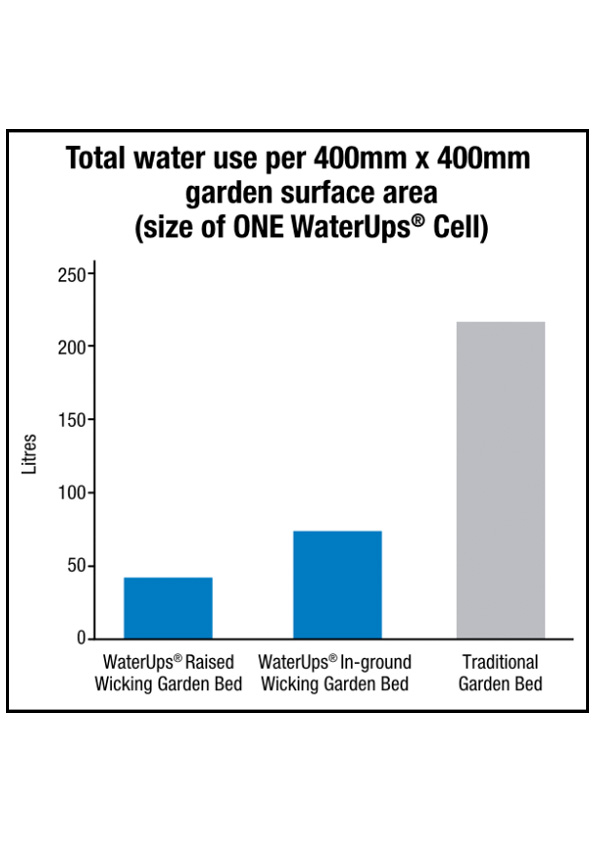About Wicking
How WaterUps Advanced Wicking
The Rise of Wicking Garden Beds
Wicking Garden Beds have become increasingly popular as more people understand the benefits of the wicking watering system in reducing garden watering requirements while at the same time producing more prolific plants.
What is Wicking?

Wicking is the movement of liquid by ‘capillary action’, where moisture is drawn upwards due to surface tension and the interaction of adhesive and cohesive forces. If you think of old-fashioned lanterns, the base of the wick would sit inside an oil or kerosene well and draw the oil up to the top of the wick so that it could burn when lit.
A wicking garden bed works in a similar way. It uses wicks or “feet” to sit in a well of water to draw water and nutrients up into the lower levels of soil. From there they are taken up by the roots into the trunk, then the leaves, fruit and flowers of plant. In wicking beds, water is drawn up into the pore spaces in the soil to a height of about 350mm.
Wicking has occurred naturally on earth since rivers first formed. Archaeological evidence of gardens irrigated by capillary action dates back about 2,500 years to near the City of Old Jerusalem. In more modern times, ‘Popular Mechanics’ magazine in 1909 made mention of a “Self Watering Flower Box” that “protects plants from neglect” and a patent was granted in the United States in 1917 for a sub-irrigated planter.
There, they use the term “sub-irrigated pots” or SIP’s. In Australia, we use the terms “wicking” and “wicking beds”. Wicking is a system that fall under the category of ‘sub-irrigation’, which include ebb and flow systems, flood floors, dutch trays and capillary matts. Importantly, wicking is the most versatile, efficient, and effective sub-irrigation system for residential, civil and commercial use for growing both ornamentals and edibles.
With water in Australia a scarce resource, due to our climatic conditions and at times harsh growing environment, in recent decades there has been a renewed interest in wicking to help grow plants and keep them healthy Wicking systems have also preformed very well in La Nina conditions on the east coast of Australia. Because of the overflow mechanism our wicking beds avoid water saturated soil.
Why use Wicking Garden Beds
Wicking garden beds eliminate the problem of deciding when and how much to water. Plants in a wicking bed can last up to 4 weeks or longer without additional watering. In contrast surface watering can require daily watering depending on climatic conditions. For people who manually do this, this can be very time-consuming, and you can end up being a slave to your garden. Few people have time for this, given the busy lives they lead. As a result, their gardens and plant suffer. For those that install drip watering systems, spray nozzles or sprinklers, there can be considerable water waste in the quest for vibrant gardens and abundant fruit and vegetables. Also, these systems tend to require regular maintenance.
This simple video captures how a wicking system works and makes life easier:
A Water Wicking System – Essential Elements
To create a wicking system, you need 4 key elements
1. A TANK OR RESERVOIR TO HOLD WATER.
We offer a choice of pre-formed Reservoir liners for pre-built raised garden beds, an enclosed irrigation trough system or pond liner.
2. A MEDIUM – OR WICK – TO TRANSFER THE WATER UP INTO THE SOIL
This is what differentiates WaterUps® Systems from all others and makes it so powerful and efficient.
At the heart of WaterUps is a recycled plastic cell Unit that has 4 feet – WICKS – with tiny perforations at the base. We fill these feet up with Perlite, a lightweight porous stone – it’s the only medium we recommend for these reasons. The perlite wicks create a powerful conduit for drawing up the water to the soil level above.
Other commercial or DIY designs might use gravel, river sand or scoria filling up the entire reservoir with this wicking layer. That is an excessive use of materials and as our tests have proven not as efficient as the perlite wicking feet. In our wicking garden beds, we use a row of wicking cells that will happily sit in the reservoir for decades – such is the quality of the recycled plastic used. The wicking cell also enables – for the first time ever – scalability – any size wicking garden bed is possible.
3. AN OVERFLOW PIPE BECAUSE TOO MUCH WATER IN THE RESERVOIR WILL LEAD TO ROOT ROT
We include this with all custom and packaged raised garden beds
4. AN INLET PIPE TO TOP UP THE WATER RESERVOIR
Again, this is included with all WaterUps orders. We will also soon offer an automated top up hose option which will add more water once the water in the reservoir drops below a certain level
Above Ground or in Ground Wicking Beds
Wicking Beds have historically been used above ground in raised garden beds. These are termed ‘closed’ wicking systems. However, they can also be used inground to deliver better results than a garden at ground level with no wicking system. These are termed ‘open’ wicking systems. (See next section). When a wicking bed is used inground there is wicking that happens beyond the parameters of the wicking cell, spreading the water into nearby soil, resulting in the wicking reservoir emptying faster than above ground set-ups. This is because it is watering a larger area. A raised wicking garden bed is for many planting situations the best type of garden bed you can have.
Massive Water Savings with WaterUps
Apart from having to water less frequently with a wicking garden bed, as noted earlier, there is a substantial saving of water itself in using the wicking method.
In 2018 a Sydney Garden Research Centre, conducted a water usage trial comparing the performance of WaterUps wicking systems. The 90-day trial found that WaterUps Wicking System in a raised garden bed uses 20% of the water of traditional in ground garden bed with top irrigation methods.
Peter Rutherford, Senior Ecologist also, noted that “our regular observations of the gardens showed that the plants in the wicking bed gardens maintained a more even and ‘lush’ growth, compared to the plants in the traditional gardens.”
Click on the Trial Results Image to read a large size version of the full report.
To gain the benefits that come from water wicking, the type of Wicking Garden Bed system you use is key, as is the material you use for your wicks.
WaterUps R&D Revolutionises Wicking Garden Beds
WaterUps introduced its unique wicking cell in 2016. Until then, all “wicking” applications were inbuilt in raised planters.
WaterUps wanted to create a product that would see wicking used in practically any garden environment– not just in raised garden bedss and pots, but in free form designs, in rooftop gardens, in horticulture and in open space gardens. We have also found wicking systems useful for improving the efficiency and longevity of rain gardens.
THE RESULT IS THE WORLD’S FIRST SCALABLE WICKING SYSTEM.
Ours is a modular design made from 100% recycled plastic, strong enough to withstand being driven over by a tractor that can be applied to any plant watering environment to deliver efficient water usage and savings and improved plant health, yield and longevity.
WaterUps is a world first and we continue to pursue R&D efforts so it can be used in even more applications than it is already today.
Academic Research on Wicking
A Semi-Systematic Review of Capillary Irrigation: The Benefits, Limitations, and Opportunities
Niranjani P. K. Semananda, James D. Ward and Baden R. Myers ID
School of Natural and Built Environments, University of South Australia.
Published: 1 Sept 2018
Extract: “This identifies that traditional capillary irrigation systems such as capillary wicks, capillary mats, and the ebb and flow systems have been shown to produce higher crop yields and use less water than conventional irrigation methods.”
Subirrigation: Historical Overview, Challenges, and Future Prospects
Rhuanito Soranz Ferrarezi, et al
Article in HortTechnology
Published: June 2015
Extract: “The first documented sub-irrigation system was described in 1895, and several variations on the basic design were used for research purposes before the modern ebb-and-flow type systems emerged in 1974.”
An evaluation of conventional and subirrigated planters for urban agriculture: Supporting evidence
Clare Sullivan, et al
First published online 25 April 2014
Extract: “This study provides critical information about potential yields and economic returns on an urban garden scale, where individuals, be they gardeners, farmers or project coordinators, make decisions about allocating scarce resources.”
An approach for quick estimation of maximum height of capillary rise
Qiang Liu, Noriyuki Yasufuku, Jiali Miao and Jiaguo Ren
Shandong University and Kyushu University
Published: 28 August 2014
A new solution was developed for quickly and easily estimating the maximum height of the capillary rise. The results obtained by the solution are compared with a series of experimental data from open-tube capillary rise tests.
Evaluating the Efficiency of Wicking Bed Irrigation Systems for Small-Scale Urban Agriculture
Semananda, et al
School of Natural and Built Environments, University of SA.
Published: 26 September 2016
Extract: “Overall, the results of this study indicated that WBs matched (or exceeded) WUE and yield achieved with best-practice surface irrigation.”


